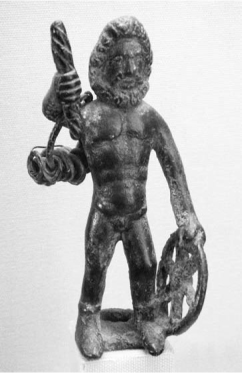Celtic MythologyWho Were the Celts? |
What was the pantheon of the Continental Celts? |
Julius Caesar in his de Bello Gallico (Gallic Wars) is our major source for Continental Celtic mythology. In the typical Roman fashion of absorbing foreign or conquered gods, Caesar assumes Roman identity for the Celtic gods. Because figures of a god of arts, crafts, and journeys seemed to be everywhere in Gaul, Caesar considers this god to be the most important Celtic deity. Caesar identifies him as Mercury. He also identifies a god who cures disease as Apollo, a god who rules the heavens as Jupiter, a god of war and healing as Mars, and a goddess of arts and crafts as Minerva. The Gaulish Mercury sometimes had three heads, suggesting the Indo-European tripartization. Caesar’s Celtic Apollo was, in fact, a composite of several deities, including the solar gods Belenus and Grannus and a thermal god Bormo who was himself associated with Damona, a figure in the Indo-European tradition of the bovine goddess. Caesar’s Minerva was really Sulis or Belisama, probably a Great Goddess representing the land itself.
The Roman writer Lucan tells us that “harsh Teutates, “dread Esus,” and Taranis all were gods demanding sacrifice. Taranis was apparently a god of the Underworld, who, according to Caesar, the Celts saw as their ancestor. Some scholars have seen the Teutates-Esus-Taranis combination as a typical Indo-European tripartization, equivalent to the early Roman Jupiter-Mars-Quirinus triad.

A bronze Gallic figure of Taranis, a god of the Underworld, holding wheel and thunderbolt.
